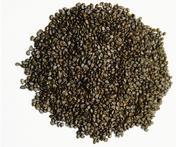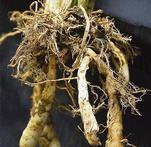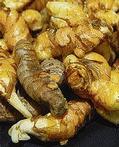Keisha Shakespeare-Blackmore, Staff Reporter



Left: Dandelion seeds. Center: Turmeric is a member of the ginger family and is commonly used in curries. Turmeric is thought to have many healthy properties. It may be taken as a dietary supplement and is said to help with stomach problems.
Right: Arrowroot is a heritage food of Jamaica that has many medicinal properties. Plus, it is great ingredient used in soups, sauces, and porridge. - Norman Grindley/Deputy Chief Photographer
Arrowroot (Maranta Arundinacea)
Arrowroot was popularly grown in Jamaica and is native to South America and the Caribbean. It has traditionally been used by most of the Indian tribes in the West Indies and Central America and its name is supposedly derived from its use in curing wounds inflicted by poisoned arrows.
The earliest uses of the plant seem to have been religious and medicinal, though it has always been important as a source of food. Arrowroot was also used for babies and invalids and a thickener for soups and sauces.
In earlier times, the local indigenous people used its root as a poultice for smallpox sores, and as an infusion for urinary infections. It may be used for diarrhoea by washing the roots, grating, then boiling them in the same water 'to make a thick pap'.
Arrowroot is used in herbal medicine as a soothing demulcent and a nutrient of benefit in convalescence and for easing digestion. It helps to relieve acidity, indigestion and colic, and is a mild laxative. It may be applied as an ointment or poultice mixed with some other antiseptic herbs such as comfrey.
It may also be used as a dyspeptic to relieve complaints of bladder and urethra; as a diuretic, an eyewash and to cure dysentery and sunburn as well as for back strength and to make porridge.
Jokoto
Jokoto looks just like callaloo and grows wild in the rural parts of the island. It likes the Irish potato fields of places like Harrywatch in Manchester and though much like callaloo, it has a spike at the end of the leaves. Once removed it is perfect for pepper pot soup that it is commonly used for by locals. When boiled over food such as yam and bananas, just remove, chop finely and simmer with some corned pork and seasoning. Yummy!
Turmeric (Curcuma longa)
Turmeric also called turmeric is a spice that is a member of the ginger family, (zingiberceae). It is commonly used in curries. It is a significant ingredient in most commercial curry powders. In fact, this was what country folk used for curries long ago.
It is also used to give a yellow colour to some prepared mustards, canned chicken broth, and other foods (often as a much cheaper replacement for saffron). Also it makes a cheap fabric dye.
In traditional medicine, turmeric is thought to have many healthful properties. It may be taken as a dietary supplement that is said to help with stomach problems. In Okinawa in Japan it is popularly served as tea. It is currently being investigated for possible benefits in Alzheimer's disease, cancer and liver disorders.
Turmeric is mildly aromatic and has aroma of orange or ginger. It has a pungent, bitter flavour. It is used in canned beverages, baked products, dairy products, ice cream, yoghurts, yellow cakes, biscuits, popcorn-colour, sweets, cake icings, cereals, sauces, and gelatines. In combination with annotto, it has been used to colour cheeses, dry mixes, salad dressings, winter butter and margarine.
Turmeric is a classic addition to chutneys, pickles, and relishes. Add a pinch of turmeric to fish soups. Blend with melted butter and drizzle over cooked vegetables, pasta, or potatoes.
Eddo
Eddo is a large tuber that is grown in hilly area of Jamaica. In some other parts of the world it is known as taro, dasheen or kalo.
Eddo is similar in characteristics to the Jamaican dasheen but it is much bigger. On the island, most locals use it to feed pigs but it is eaten as a starch in other countries.
Eddo has a brown fibrous skin and grey to white (sometimes purple-tinged) flesh. The roots range in length from about five inches to a foot or more, and can be several inches wide. Though acrid-tasting in its raw state, the root has a somewhat nut-like flavour when cooked. It is also extremely easy to digest. It should be noted, however, that some varieties are highly toxic unless thoroughly cooked. It has a large edible leaves that can be prepared and eaten like mustard or turnip greens. It is used in place of a potato.
Sweet Cassava(Manihot esculenta)
This is a popular root crop of the West Indies and Central and South America from where it was taken to the east of Africa.
In Jamaica, cassava comes in two varieties: sweet and bitter and is very hard to distinguish between them. The sweet variety can simply be cooked and eaten as a starch as customary here. Bitter cassava however, has a high prussic acid and to be processed before use to dissipate the poison. Also this is the variety that is used to make ever-popular bammy.
The cassava's roots are long and tapered with a firm homogeneous flesh. It is encased in a detachable rind, about one millimetre thick. A woody cordon runs along the root's axis. The flesh can be chalk-white or yellowish and darkens quickly when exposed to air. For this reason, the skinned root must be kept under water until it is ready to be cooked.
Cooked in various ways, cassava is used in a great variety of dishes. The soft-boiled root has a delicate flavour and can replace boiled potatoes in many uses. It may be used as an accompaniment for meat dishes, in soups, and stews. Deep fried (after boiling or steaming), it can replace fried potatoes. Also it can great for making chips. Plus, back in the days people usually use the cassava to make flour.
Foods we ate then but not much now
One of the great things about growing up in the rural parts of our island is the good introduction to most of the fruits and foods of Jamaica. For the most part, country folk live off the land and there is hardly a day when there is absolutely nothing to eat. However hungry, some ground provision can be reaped and mothers and grandmothers can 'tun their han an mek fashion' even for one big meal daily.
But many of the foods from our past are no longer enjoyed today as palates have become sophisticated. Sadly, these foods were also very nutritious and in many cases, they are now being sought after for their health-giving properties. Food went in search of some of these items and with the help of Epel and Pearline Sandford from Sanguinetti, Clarendon, Gleaner freelancer George Henry, as well a Monica and Sonny Roberts from Spice Grove in Manchester, here is our list of heritage foods.
Dandelion (Cassia
Occidentailis)
Dandelion has been used for medicinal purposes since the
10th century. It shows proven value as a diuretic, flushing excess water from the body. It also promotes the flow of bile and stimulates the appetite. Dandelion juice once enjoyed considerable
popularity as a diuretic, laxative, and remedy for rheumatism. In folk medicine,
it is also used as
a remedy for
hemorrhoids, gout, rheu-matism, eczema, other skin
conditions, and diabetes.

